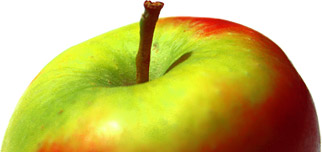This is an American variety, also known as Bill's Redflesh and Firecracker, and one of the most extreme examples of a red-fleshed apple variety. The red tendency dominates this apple, with not only the skin and flesh but also the leaves, wood, and blossoms all having a very pronounced red stain to them.
The apples are fairly small, round-conical and often slightly elongated in shape, usually about two inches in diameter, and two and a quarter inches deep. The stalk is of medium length, fairly thick, in a shallow cavity, projecting beyond the base. The skin is wholly red and smooth, sometimes with pale dots (lenticels). The flesh is deep pink to red, soft, and tender; the juice is sweet and tart. The eye is closed and there is little or no cavity. The appearance is very similar to Almata (also American) and Huonville Crab (Australian). There are apples in most years, though there is some tendency to be biennial.
This apple is more acidic than most dessert varieties, having an intense sharp brisk flavour. It keeps in good condition for about a week. After this time the acidity declines and the apple begins to shrink slightly. After a fortnight the acidity is less pronounced, the taste is sweeter and the texture rather soft and doughy.
The tree is slender and partial tip-bearing. The blossom is wholly red, new leaves are bronze-coloured, and the wood is red-stained. The flowering period is extremely early; about 20 days earlier than Bramley. It is one of the first apple trees in the orchard to flower. It is a very poor pollinator. The tree grows rapidly and vigorously.
We are grateful to Nigel Deacon, an English apple enthusiast with a particular interest in red-fleshed apple varieties, for samples and background of this apple variety. There are details of many more red-fleshed apples on his website and he can supply / exchange seeds and scionwood - see Diversity website.
USDA identification images for Scarlet Surprise
The identification paintings in the USDA Pomological Watercolor Collection span the years 1886 to 1942.
Citation: U.S. Department of Agriculture Pomological Watercolor Collection. Rare and Special Collections, National Agricultural Library, Beltsville, MD 20705.
Visitor reviews
- 03 Dec 2012 VEJLE, DenmarkYou could try one of the new red-fleshed apples from Lubera - it is a series called Redlove. http://www.dobies.co.uk/Garden/Fruit/Fruit+Trees/Apple+Trees/list.htm
- 27 Nov 2012 LEICESTERSHIRE, United KingdomYes, this is the one registered by Stark Brothers. I prefer the name 'Scarlet Surprise' but it is known as Bill's Redflesh and (more recently) Firecracker in some circles. Until cut through it can't be readily distinguished from 'Almata' but the flesh colour is darker in most years.
- 07 Jun 2011 GA, United StatesStark Brothers lists both Scarlet Surprise and Bill's Red Flesh on the tags for this tree.
- 14 May 2011 AustraliaIs this the same 'Scarlet Surprise' that is registered by Stark Brothers, or is it the unregistered one that is also known as 'Bill's Red Flesh' and 'Firecracker', and was introduced by either Bill Schulz or Oregon State University? Any clarification on this point is welcome!
Tree register
United States
- Albany Appleguy in Castleton, NY
- John R. Szakacs in Ben Lomond, CA
- Justinkrivers in Amsterdam, NY
- Kim Lapacek in Poynette, WI
- Ronny Blackstock in Fitzgerald, GA
- Whitney Peters in Sixes, OREGON
France
- Sylveno in Le Frayssé, TARN
Portugal
- Luis Godinho in Sao Mamede, BATALHA
Spain
- Jorge Ramirez in VALENCIA, VALENCIA
India
- Nitish Chauhan in Rajgarh, HIMACHAL PRADESH
- Sachin Kashyap in Kumarsain, HIMACHAL PRADESH
Origins
- Species: Malus domestica - Apple
- Originates from: United States
Identification
- Country of origin: United States
- Fruit colour: Red
- Flower colour: Pink
- Leaf colour: Bronze
- Annual cycle: Deciduous
- Flowering duration: Average (2-3 weeks)
- Flesh colour: Pink / Red
- Fruit size: Small
- Leaf colour - autumn: Bronze / Purple
Using
- Picking season: Early
- Keeping (of fruit): 1 week
- Flavour quality: Good
- Flavour style (apples): Sharper
- Discoloration of fruit: Very oxidising (browns quickly)
- Cropping: Good
- Fruit persistence: Normal ripening
- Food uses: Eating fresh
- Food uses: Culinary
- Picking month: August
- Picking period: early August
- Picking period: mid-August
- Wildlife: RHS Plants for Pollinators
Growing
- Gardening skill: Average
- Flowering group: 1
- Pollinating others: Poor
- Ploidy: Diploid
- Vigour: Average vigour
- Bearing regularity: Regular
- Fruit bearing: Partial tip-bearer
- Attractive features: Attractive flowers
- Self-fertility: Not self-fertile
Climate
- Climate suitability: Temperate climates
- Cold-hardiness: Cold-hardy
- Summer average maximum temperatures: Cool ( 20-24C / 68-75F)
- Summer average maximum temperatures: Warm (25-30C / 76-85F)
Other qualities
- Disease resistance: Average
Where to buy trees
The following tree nurseries offer Scarlet Surprise apple trees for sale:
- Thomas Fruit Trees (EU) France
Scarlet Surprise apple trees
Where to buy fresh fruit
The following orchards grow Scarlet Surprise:
United States
Colorado
- Masonville Orchard, Fort Collins
Minnesota
- Sweetland Orchard, Webster

